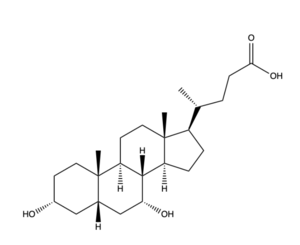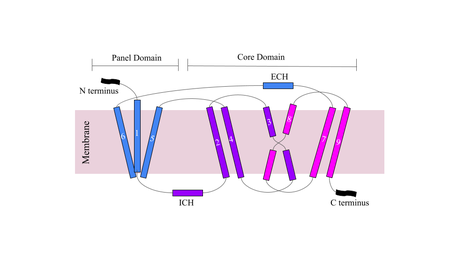Sandbox Reserved 1783
From Proteopedia
(Difference between revisions)
| Line 6: | Line 6: | ||
[[Image:Fig_1.png|400 px|right|thumb|'''Figure 1.''' NTCP structure with both Na+ ions and bile salts bound with the NTCP molecule shown in light blue, the two Na+ ions shown in purple spheres, and the bile salts shown in sticks as dark blue. [PDB file 7ZYI].]] | [[Image:Fig_1.png|400 px|right|thumb|'''Figure 1.''' NTCP structure with both Na+ ions and bile salts bound with the NTCP molecule shown in light blue, the two Na+ ions shown in purple spheres, and the bile salts shown in sticks as dark blue. [PDB file 7ZYI].]] | ||
| - | + | Sodium taurocholate co-transporting polypeptide (NTCP) is a sodium-dependent transporter that is responsible for the transportation of bile salts from the blood into epithelial liver cells. <Ref name="Goutam"> Goutam, K., Ielasi, F.S., Pardon, E. et al. Structural basis of sodium-dependent bile salt uptake into the liver. Nature 606, 1015–1020 (2022). [https://doi.org/10.1038/s41586-022-04723-z DOI: 10.1038/s41586-022-04723-z]. </Ref> NTCP is a secondary active transport molecule that couples the thermodynamically favorable movement of Na+ ions with the unfavorable transport of bile salts into the cell (Fig. 1). | |
| - | + | The bile salts transported by NTCP in the gastrointestinal tract are involved in digestion, nutrient absorption, fat breakdown, and lipid soluble nutrient transport. <Ref> Maldonado-Valderrama, J., Wilde, P., Macierzanka, A., & Mackie, A. (2011). The role of bile salts in digestion. Advances in colloid and interface science, 165(1), 36–46. [https://doi.org/10.1016/j.cis.2010.12.002 DOI: 10.1016/j.cis.2010.12.002]. </Ref> NTCP is found within the basolateral membrane hepatocytes. <Ref name="Asami"> Asami J, Kimura KT, Fujita-Fujiharu Y, Ishida H, Zhang Z, Nomura Y, Liu K, Uemura T, Sato Y, Ono M, Yamamoto M, Noda T, Shigematsu H, Drew D, Iwata S, Shimizu T, Nomura N, Ohto U. Structure of the bile acid transporter and HBV receptor NTCP. Nature. 2022 Jun; 606 (7916):1021-1026. [https://dx.doi.org/10.1038/s41586-022-04845-4 DOI: 10.1038/s41586-022-04845-4]. </Ref> The uptake of bile salts into the liver also allow for drugs and fat soluble vitamins to be both absorbed and excreted in the small intestine. NTCP also acts as a receptor for Hepatitis B virus (HBV) and Hepatitis D virus (HDV) which infect human livers through endocytosis when bound. The myristoylated (myr) <scene name='95/952711/Pres1_binding_area_on_ntcp/3'>pre-S1</scene> domain of HBV, specifically residues 8-17, is critical for its binding to NTCP which halts the uptake of bile salts, indicating that HBV/HDV bind to NTCP at the same site as bile salts. <ref name="Goutam"/> | |
[[Image:Bile Salt structure.png|300 px|left|thumb|'''Figure 2.''' Bile Salt Structure.]] | [[Image:Bile Salt structure.png|300 px|left|thumb|'''Figure 2.''' Bile Salt Structure.]] | ||
| Line 14: | Line 14: | ||
== Structural Overview == | == Structural Overview == | ||
| - | NTCP has 9 transmembrane alpha helices (TM) that form the protein, with an extracellular N-terminus and intracellular C-terminus. NTCP has two domains within the protein, <scene name='95/952711/Panel_domain/1'>a panel domain</scene>, made up of TM1, TM5, and TM6, and <scene name='95/952711/Core_domain/3'>a core domain</scene>, made up of TM2-4 and TM7-9. An interesting feature of NTCP is the cross of TM3 and TM8 that form an <scene name='95/952711/X_motif/1'>X motif</scene> within the protein that is used in the conformational change of NTCP. The two domains are essential to the conformation change of NTCP to bind bile salts. <Ref name="Xiangbing"> Xiangbing Qi, Wenhui Li. (2022). Unlocking the secrets to human NTCP structure. The Innovation, Vol. 3, Issue 5. 100294, ISSN 2666-6758, [https://doi.org/10.1016/j.xinn.2022.100294 DOI: 10.1016/j.xinn.2022.100294]. </Ref> | + | NTCP has 9 transmembrane alpha helices (TM) that form the protein, with an extracellular N-terminus and intracellular C-terminus. NTCP has two domains within the protein, <scene name='95/952711/Panel_domain/1'>a panel domain</scene>, made up of TM1, TM5, and TM6, and <scene name='95/952711/Core_domain/3'>a core domain</scene>, made up of TM2-4 and TM7-9. An interesting feature of NTCP is the cross of TM3 and TM8 that form an <scene name='95/952711/X_motif/1'>X motif</scene> within the protein that is used in the conformational change of NTCP. The two domains are essential to the conformation change of NTCP to bind bile salts. The intracellular α-helix (ICH) connects TM1 and Tm2. The extracellular α-helix connects TM6 and TM7. <Ref name="Xiangbing"> Xiangbing Qi, Wenhui Li. (2022). Unlocking the secrets to human NTCP structure. The Innovation, Vol. 3, Issue 5. 100294, ISSN 2666-6758, [https://doi.org/10.1016/j.xinn.2022.100294 DOI: 10.1016/j.xinn.2022.100294]. </Ref> |
There are two significant patches in the NTCP structure that facilitate ligand binding. Residues 84-87 of NTCP are <scene name='95/952711/Binding_patch_1/1'>Patch 1</scene>, which are located on the TM2-TM3 loop in the core domain. This patch is also considered the extracellular region of the binding tunnel within NTCP. Residues 157-165 of NTCP are associated with <scene name='95/952711/Binding_site_2_with_surface/1'>Patch 2</scene>. They are located on the N-terminal half of the TM5 in the panel domain (residue sequence: KGIVISLVL). Patch 2 is also located in the extracellular region of the binding tunnel. These residues' importance was determined through mutations of these residues and examined through pull-down assays. <ref name="Asami"/> The pre-S1 domain of HBV/HDV binds to the patches on NTCP in order to transport the virus from the exterior of NTCP to the interior binding tunnel to infect human liver cells.<ref name="Goutam"/> | There are two significant patches in the NTCP structure that facilitate ligand binding. Residues 84-87 of NTCP are <scene name='95/952711/Binding_patch_1/1'>Patch 1</scene>, which are located on the TM2-TM3 loop in the core domain. This patch is also considered the extracellular region of the binding tunnel within NTCP. Residues 157-165 of NTCP are associated with <scene name='95/952711/Binding_site_2_with_surface/1'>Patch 2</scene>. They are located on the N-terminal half of the TM5 in the panel domain (residue sequence: KGIVISLVL). Patch 2 is also located in the extracellular region of the binding tunnel. These residues' importance was determined through mutations of these residues and examined through pull-down assays. <ref name="Asami"/> The pre-S1 domain of HBV/HDV binds to the patches on NTCP in order to transport the virus from the exterior of NTCP to the interior binding tunnel to infect human liver cells.<ref name="Goutam"/> | ||
| Line 22: | Line 22: | ||
=== Binding Pocket === | === Binding Pocket === | ||
| - | + | <scene name='95/952711/Sodium_residue_zoom_in_nctp/1'>Sodium binds to residues 84-87 and 157-165 within NTCP </scene>. The binding pocket forms a tunnel structure within NTCP at the interface of two domains that connects the external cytoplasm of the hepatocyte to the basolateral membrane. The face of the tunnel where the bile salts bind is lined with hydrophilic residues, whereas the opposite face of the transmembrane helices is hydrophobic, making the tunnel amphipathic. <Ref name="Liu"> Liu, H., Irobalieva, R.N., Bang-Sørensen, R. et al. Structure of human NTCP reveals the basis of recognition and sodium-driven transport of bile salts into the liver. Cell Res 32, 773–776 (2022). [https://doi.org/10.1038/s41422-022-00680-4 DOI: 10.1038/s41422-022-00680-4]. </Ref> The hydrophilic tunnel allows hydrophilic bile salts and sodium ions to be transported across the hydrophobic cell membrane. In the <scene name='95/952710/Tunnel_front/1'>outward facing state</scene> with no bile salt bound to the tunnel, it forms a hollow hole in the middle of the structure. When bile salts bind within, these bile salts completely occlude the <scene name='95/952710/Bile_bound_to_tunnel/2'>tunnel</scene>. | |
Revision as of 20:44, 10 April 2023
| This Sandbox is Reserved from February 27 through August 31, 2023 for use in the course CH462 Biochemistry II taught by R. Jeremy Johnson at the Butler University, Indianapolis, USA. This reservation includes Sandbox Reserved 1765 through Sandbox Reserved 1795. |
To get started:
More help: Help:Editing |
Sodium Taurocholate Co-Transporting Peptide
| |||||||||||
References
- ↑ 1.0 1.1 1.2 1.3 1.4 Goutam, K., Ielasi, F.S., Pardon, E. et al. Structural basis of sodium-dependent bile salt uptake into the liver. Nature 606, 1015–1020 (2022). DOI: 10.1038/s41586-022-04723-z.
- ↑ Maldonado-Valderrama, J., Wilde, P., Macierzanka, A., & Mackie, A. (2011). The role of bile salts in digestion. Advances in colloid and interface science, 165(1), 36–46. DOI: 10.1016/j.cis.2010.12.002.
- ↑ 3.0 3.1 Asami J, Kimura KT, Fujita-Fujiharu Y, Ishida H, Zhang Z, Nomura Y, Liu K, Uemura T, Sato Y, Ono M, Yamamoto M, Noda T, Shigematsu H, Drew D, Iwata S, Shimizu T, Nomura N, Ohto U. Structure of the bile acid transporter and HBV receptor NTCP. Nature. 2022 Jun; 606 (7916):1021-1026. DOI: 10.1038/s41586-022-04845-4.
- ↑ Xiangbing Qi, Wenhui Li. (2022). Unlocking the secrets to human NTCP structure. The Innovation, Vol. 3, Issue 5. 100294, ISSN 2666-6758, DOI: 10.1016/j.xinn.2022.100294.
- ↑ Liu, H., Irobalieva, R.N., Bang-Sørensen, R. et al. Structure of human NTCP reveals the basis of recognition and sodium-driven transport of bile salts into the liver. Cell Res 32, 773–776 (2022). DOI: 10.1038/s41422-022-00680-4.
- ↑ Vlahcevic, Z., Buhac, I., et al. Bile Acid Metabolism in Patients with Cirrhosis. Gastroenterology vol. 60, 491-498 (1971). DOI: 10.1016/S0016-5085(71)80053-7.
![Figure 1. NTCP structure with both Na+ ions and bile salts bound with the NTCP molecule shown in light blue, the two Na+ ions shown in purple spheres, and the bile salts shown in sticks as dark blue. [PDB file 7ZYI].](/wiki/images/thumb/3/36/Fig_1.png/400px-Fig_1.png)



